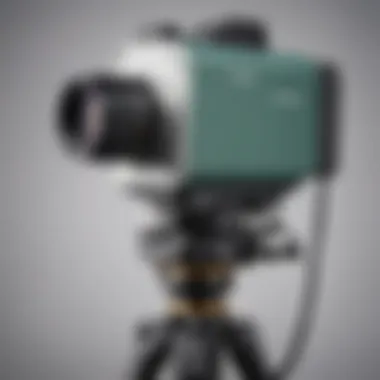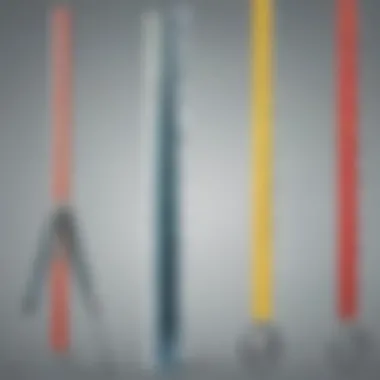Innovative Camera Techniques for Accurate Height Measurement


Intro
In recent years, advancements in technology have revolutionized many fields, including the measurement of height. Using a camera to measure height may seem unconventional, but it is grounded in real scientific principles. This practical guide aims to elucidate how height can be accurately measured with a camera. By harnessing techniques such as photogrammetry, individuals from various fields, including education, medicine, and sports, can enhance their practices.
Science Fun Facts
The world of measuring height with a camera is filled with intriguing facts. Each year, scientists and educators strive to find innovative solutions for measurement challenges. Here are some interesting points:
- Photogrammetry: This method relies on photographs to create precise measurements of objects or space.
- Historical Usage: The practice of measuring with images dates back to the early 19th century, showcasing its long-standing utility.
- Remote Sensing: Cameras are used in aerial perspectives, allowing for height measurements that would otherwise be difficult to achieve.
- High Accuracy: Many camera-based measurement methods now boast a precision of less than a centimeter, making them suitable for serious applications.
"Photogrammetry is not just about capturing images; it's about transforming those images into workable data for a range of fields."
Tools Required
To begin measuring height with a camera effectively, a few essential tools and equipment are needed:
- A high-quality camera with good resolution
- A measuring reference object, like a ruler or a known height object
- Software or an application that offers photogrammetry capabilities
- A stable surface to place the camera
With these tools at hand, anyone can begin to explore the fascinating world of photographic height measurement.
Techniques for Measurement
Understanding how to take measurements accurately is the next step. The process generally includes:
- Setting Up the Environment: Ensure the subject is in good lighting and that the camera is positioned firmly.
- Capturing the Image: Take multiple images from different angles to create a comprehensive dataset.
- Using Technology: Utilize photogrammetry software to analyze the images and calculate the height based on the references provided.
- Verification: Cross-check measurements with traditional methods to ensure accuracy.
Mistakes to Avoid
Accuracy is vital in this process. Here are common mistakes to be aware of:
- Not using a stable camera support
- Taking images without sufficient detail
- Forgetting to measure the reference object’s height
By following the guidelines laid out, individuals can surpass these common pitfalls.
Ending
Measuring height using a camera is an approach that blends innovation with scientific principles. As technology continues to advance, so too do methods of measurement. Learning how to apply these tools and techniques not only fosters practical skills but also enhances understanding in various domains. By embracing this modern method, educators and practitioners alike can achieve new levels of precision in their work, paving the way for further advancements.
Preamble to Measuring Height with a Camera
Measuring height accurately is essential in many fields like education, healthcare, and sports. Traditional methods, while effective, may pose challenges in certain scenarios. The advent of camera-based measurement represents a significant shift. It allows for greater precision and ease of use, enabling measurements without direct contact. This guide explores these modern techniques and their practical applications.
The Evolution of Measurement Techniques
Historically, measuring height involved manual tools like measuring tapes and stadiometers. These methods require physical interaction, which can lead to errors. Early technologies used rudimentary optical methods. With time, tools advanced, incorporating devices like laser levels. Each innovation made measurements faster and often more accurate. Today, cameras provide a new layer of capability. They can capture detailed images and enable measurements through software applications. This evolution reflects a continuous search for better accuracy and efficiency.
Relevance in Today's Technological Landscape
In our current age, where precision is paramount, measuring height with cameras has gained traction. With smartphones equipped with advanced imaging technology and features, anyone can measure height accurately. The relevance of this method is vast. In education, teachers can track student growth effectively. In medicine, doctors monitor patient development. In sports, coaches analyze player performance metrics. Moreover, this innovation aligns with the increasing use of data analytics and digital solutions. Adopting camera-based methods meets the demand for accuracy in a fast-paced world.
Measuring height with a camera not only provides convenience but also enhances the reliability of data collected across various sectors.
Understanding Photogrammetry
Photogrammetry is an essential concept in the context of measuring height using a camera. This technique utilizes photographs to obtain precise measurements of objects and terrains. Understanding photogrammetry is crucial because it forms the backbone of how height measurement is conducted in various spheres—be it in education, sports, or medical fields. Knowing how photogrammetry works enables users to gather spatial data accurately, thus enhancing the reliability of information they obtain.
The benefits of mastering photogrammetry are significant. It not only provides accurate measurements but also allows for the analysis of these measurements from different angles. This adds depth to the interpretations that can be made from the data collected. Moreover, photogrammetry can be conducted using many types of cameras, making it accessible to a broader audience.


Yet, there are considerations to keep in mind. High-quality images are essential for effective photogrammetry. Users must ensure that the camera settings, lighting conditions, and angles are optimal for gathering usable data. Any mistake in these areas could lead to inaccuracies in height measurements, undermining the whole process. Therefore, a solid understanding of both technical and practical elements of photogrammetry is vital for anyone looking to measure height using a camera.
Basic Principles of Photogrammetry
The basic principles of photogrammetry revolve around capturing images of an object or scene from multiple viewpoints. These images are then analyzed to extract 3D information. The process typically follows three critical steps:
- Image Capture: Multiple images taken from different angles are necessary to create a three-dimensional representation.
- Image Processing: Specialized software processes the images, aligning them and extracting measurement data.
- Data Interpretation: Users analyze the output from the software to derive useful insights such as height, volume, and even surface area.
By relying on geometric relationships within the images, photogrammetry can create accurate models that represent the real-world dimensions of objects. This precision can be invaluable in various contexts.
Applications of Photogrammetry
Photogrammetry has a wide range of applications that showcase its versatility and usefulness:
- Sports: Coaches and trainers use this technique to analyze athletes' performances, allowing for tailored training plans based on accurate height and physique evaluations.
- Medical Fields: Hospitals often implement photogrammetry for tracking growth in pediatric patients. By measuring height accurately over time, caregivers can make informed decisions.
- Education: Teachers may use this method to create engaging learning activities involving measurements and geometry. By integrating technology, they can enhance student understanding of spatial dimensions.
The integration of photogrammetry in these fields illustrates how it transforms height measurement into a more precise and modern practice.
Essential Tools for Height Measurement
Measuring height with a camera involves several essential tools, each contributing to the overall accuracy and efficiency of the process. The choice of tools is critical, as they directly impact the quality of measurement and ease of use. Proper tools enhance the confidence in results obtained. Typical tools used for height measurement include cameras, specialized software, and supporting devices.
These tools not only help in collecting measurement data but also facilitate the interpretation and processing of photographs to yield valid height values. Users must consider the characteristics and specifications of the tools to ensure they meet the demands of different environments and measurement scenarios.
Camera Selection: Key Features
Selecting the right camera is paramount in height measurement applications. Key features to consider include:
- Resolution: Higher resolution captures clearer images, allowing for better precision in measurements. A camera with at least 12 megapixels is advisable.
- Lens Quality: The type of lens affects depth of field and image distortion. A wide aperture allows more light, benefiting photography in low-light settings.
- Stability Features: Optical image stabilization is valuable for reducing blurriness due to shake, enhancing the accuracy of height measurements.
- Compatibility: Ensure that the selected camera is compatible with measurement software.
Software and Applications for Height Measurement
Software plays an essential role in processing images taken for height measurement. It not only aids in calculations but also ensures accuracy in results. Different types of software exist to cater to various needs, including mobile applications and desktop software.
Mobile Applications
Mobile applications offer a convenient way to measure height on the go. They are particularly useful for field measurements where carrying heavy equipment is impractical. One key characteristic of these applications is their accessibility. Users can download and install them on their smartphones easily.
A notable feature of many mobile apps is their ability to utilize device sensors such as accelerometers or GPS to aid in measurement. This is beneficial because it allows for easy calibrations. However, the accuracy can be somewhat limited compared to professional tools or desktop software. Additionally, mobile apps require a stable connection to function optimally, which may pose challenges in remote areas.
Desktop Software
Desktop software often provides a more robust and detailed approach to height measurement. It typically offers comprehensive features for skilled users resulting in more accurate measurements. A notable characteristic of desktop software is its processing power.
These programs can handle large datasets, making them ideal for detailed projects. For instance, users may process multiple images and derive complex measurements with advanced algorithms.
However, desktop software can be less user-friendly than mobile applications due to its intricate interface. Furthermore, they often require more hardware resources, which may not be available to every user. Yet, for critical measurements, the investment is often justified due to the enhanced accuracy and detail provided.
"Choosing the right tools is crucial for achieving accuracy in measuring height with a camera. Each component plays a vital role in the effectiveness of measurement."
In summary, the tools for height measurement are fundamental to the success of the overall process. Proper camera selection and software utilization can significantly enhance measurement reliability.
Step-by-Step Guide to Measuring Height with a Camera
In this section, we will explore the systematic approach to measure height using a camera. A step-by-step guide is extremely important because it helps ensure that every measurement taken is precise and reproducible. Knowledge of practical techniques improves the overall competency in using photographic methods for measurement. These considerations assist in reducing errors and enhancing understanding.
Pre-Measurement Preparations


Preparation is essential before any measurement task. It sets the stage for accurate results. Two critical aspects of pre-measurement preparations are choosing the right setting and establishing a reference point.
Choosing the Right Setting
Choosing the right setting is vital for accurate height measurements. It involves selecting an area that will allow for optimal lighting and minimal distractions in the background. A key characteristic of a good setting is ample natural light. This enhances image clarity and reduces shadows, which can interfere with measurements. A level surface is also important as it ensures that the subject is standing in a consistent position, preventing variations in height readings.
For this article, an outdoor area with diffuse lighting, such as a cloudy day, contributes to less glare. However, indoors under fluorescent lights may lead to distortions in color. Each setting has unique features that can either enhance or hinder the accuracy of the height measurement. Hence, understanding the pros and cons of different locations is crucial.
Establishing a Reference Point
Establishing a reference point is another important consideration. This act involves pinpointing a specific object or position that can be used as a baseline for comparison. The reference point should ideally be fixed, such as the floor or a wall, which allows for consistency every time height is measured.
A key characteristic of a reference point is its visibility in the photographs taken. It should be clearly identifiable so it can be used throughout the entire process. A common choice for a reference point is the bottom of a doorframe or a marked line on a wall. However, care must be taken when selecting the reference point, as its visibility and relevance can impact the accuracy of measurements.
Creating a consistent reference point helps in tracking changes over time. This consistency is particularly useful in fields such as sports and medicine, where monitoring growth or performance is necessary. Though establishing a reference point might seem trivial, it has significant benefits in getting reliable data and enhances the overall measurement process.
Taking Accurate Photographs
The next step is to take accurate photographs. Attention to detail is critical during this phase. The goal is to capture the subject ensuring they are properly positioned and in focus. Each picture must uphold clear visibility of both the subject and the reference point. Focus on stability and use a tripod if available to avoid any shakiness.
Processing Images for Height Calculation
After taking photographs, the next phase is processing images for height calculation. Two key activities in this process are using measurement software and interpreting results.
Using Measurement Software
Using measurement software is integral to the analysis phase. This software simplifies the calculation process and provides accurate results. A prevalent key feature is the ability to scale the image accurately based on the reference point established earlier. This ability allows for effective comparisons between subjects of different heights.
Popular options for measurement software include software such as Autodesk ReCap and PhotoModeler. Each has unique characteristics that cater to various needs. While some may be user-friendly for amateurs, others are geared towards professionals. The advantages of utilizing measurement software lie in its efficiency and accuracy, making it an essential component of camera-based height measurement.
Interpreting Results
Interpreting results is the final step in our guide. Results obtained from the measurement software require careful analysis. Understanding what the figures represent is crucial for making informed decisions. This step often entails comparing various measurements over time, or assessing different subjects.
A key characteristic of interpretation is its reliance on established benchmarks. This involves understanding typical height ranges for specific demographics. Therefore, using interpreted results can allow for insights into growth or performance in specific contexts, such as clinical assessments in medicine.
Being aware of potential misconceptions in data interpretation is also important. Errors can lead to incorrect conclusions, highlighting the need for caution during this step. Thus, interpreting results effectively ensures that height measurements are informative and contextually relevant.
Ensuring Accuracy in Measurements
Accuracy in measurements is crucial when it comes to using a camera for height measurement. It affects the overall reliability of the data collected. If measurements are not precise, it can lead to errors that may impact decision-making in various fields. For instance, in medicine, accurate growth tracking is important for diagnosis, while in sports, it can affect an athlete's training regimen. Each aspect of measuring height with a camera demands meticulous attention to detail to gain valid outcomes.
Common Errors and How to Avoid Them
Several common errors can arise when measuring height with a camera. Being aware of these potential pitfalls can help in mitigating their effects.
- Incorrect Camera Position: If the camera is not placed directly perpendicular to the subject, it can cause distortion.
- Poor Lighting Conditions: Inadequate lighting can lead to shadows or blurriness, affecting clarity and precision.
- Inconsistent Reference Points: Using varying reference points for measurements can lead to discrepancies.
To avoid these errors, start by ensuring the camera is leveled properly. Use a stabilizing tool, such as a tripod, to maintain accuracy. Conduct measurements in well-lit areas to improve image quality. Always establish a consistent reference point before taking multiple measurements, which will help maintain uniformity.
Tips for Improving Measurement Precision
Enhancing the precision of height measurements can be achieved through several best practices.
- Calibrating Your Equipment: Regularly check your camera settings and calibration to ensure accuracy.
- Using Indicators: A measuring tape or similar tool can serve as a good reference during the measurement process.
- Taking Multiple Shots: The more images you capture, the better your chances are of getting an accurate measurement.
- Image Processing Software: Utilize software capable of analyzing the images effectively. Tools like Agisoft Metashape provide robust functionalities for improving measurement outcomes.
"Precision is key. Small errors can compound and lead to significant inaccuracies."


In summary, ensuring accuracy when measuring height with a camera is vital across various applications. By recognizing common errors and implementing strategies for precision, one can achieve reliable and valid results.
Case Studies: Applications in Various Fields
Measuring height with a camera has practical applications across diverse fields. Understanding these case studies can offer insights into how such measurements can enhance various practices. This section highlights the significance of implementing camera-based height measurement in sports, medical fields, and education, showcasing the benefits and considerations in each area.
Height Measurement in Sports
In the world of sports, accurate height measurements play a crucial role. This is especially true in competitive disciplines such as basketball, gymnastics, and track and field where every centimeter can influence performance. Coaches and trainers utilize precise measurements to tailor training programs to individual athletes. For example, using camera technology, they can effectively assess vertical jumps or track progress over time. This not only promotes better training strategies but also fosters an environment for athletes to reach their peak potential.
A significant advantage of employing camera-based measurement is the speed and efficiency it provides. Traditional measuring tools can be cumbersome and time-consuming. In contrast, a camera can capture height data in moments, allowing for real-time analysis. This helps teams gather vital statistics quickly during competitions or practice sessions.
Medical Applications: Tracking Growth
In medical settings, the application of camera-based height measurement serves a vital purpose, particularly in tracking a child's growth over time. In pediatric practices, healthcare professionals constantly monitor the growth trajectory to assess health and development. With accurate height measurements, doctors can diagnose growth disorders or monitor the efficacy of treatments.
Additionally, using cameras can reduce error in height measurements that often occurs with manual tools. Automated software can analyze images and provide consistent and precise results. This makes it easier for healthcare providers to communicate growth metrics to parents and caregivers, ensuring everyone stays informed. Using a camera can also streamline the process during routine check-ups, reducing time spent on physical measuring devices.
Educational Uses: Enhancing Learning
Education also benefits from camera-based height measurement, particularly in enriching science curricula. When students learn about measurement concepts in a hands-on manner, it can enhance their understanding. Teachers can engage students by incorporating camera technology into lesson plans. For instance, students can measure the height of objects in their schoolyard or classmates, using cameras as tools for recording their findings.
Such practical applications in the classroom encourage student participation and foster critical thinking skills. Students learn to apply theoretical knowledge to real-world scenarios, making their education more meaningful. Furthermore, educational institutions can employ camera measurement tools for school-wide health initiatives, monitoring student growth in an engaging way.
The integration of technology in education transforms learning environments and helps students develop analytical competences.
Future Trends in Camera-Based Measurement
The realm of camera-based measurement is continuously evolving. As technology improves, new possibilities emerge for more accurate and efficient height measurement techniques. Understanding these trends is essential for professionals and amateurs alike who utilize cameras for measurement. This section will explore the significance of keeping pace with the advancements, discussing innovations that are on the horizon and how they may influence measurement industries.
Technological Innovations on the Horizon
Advancements in technology are leading to exciting innovations in camera-based height measurement. Some key elements gaining attention include:
- 3D Imaging: Emerging cameras are designed with enhanced capabilities to capture three-dimensional data. This can improve the accuracy of measurements significantly.
- AI Integration: Machine learning algorithms are being incorporated into height measurement applications. These algorithms can streamline the process by automatically detecting reference points within images.
- Mobile Technology: The increasing power of smartphones is leading to sophisticated applications that allow height measurement directly through mobile devices. New apps are being developed that may utilize augmented reality to enhance precision in real-time.
Incorporating these innovations can lead to more reliable measurements as well as user-friendly processes. Being aware of these trends is crucial for adapting to new techniques that enhance measurement accuracy.
Potential Impact on Measurement Industries
The upcoming advancements in camera-based measurement technologies will likely exert a profound influence across various measurement industries. Here are some potential impacts to consider:
- Increased Efficiency: With AI and 3D imaging, professionals can take measurements faster. This reduces the time needed for data collection and analysis.
- Broader Applications: Height measurement can see a wider range of applications in areas such as construction, healthcare, and tourism. For example, precise measurements can ensure safe building practices.
- Cost-Effectiveness: As technology becomes more accessible and streamlined, costs for measurement tools and software can decrease, leading to a democratization of measurement tools.
"Staying informed about future trends in camera-based height measurement is essential for professionals aiming to keep their skills relevant and effective."
Keeping an eye on these changes in technology also offers the chance for organizations to adopt new strategies and tools that can ultimately enhance productivity.
Closure: The Importance of Measuring Height Accurately
Accurate height measurement is vital in various settings, from educational assessments to medical evaluations. The precision of these measurements can influence important decisions and outcomes. For example, in educational environments, knowing a child's height can aid in understanding their growth trends. In medicine, accurate height readings are essential for assessing growth patterns, especially in children and adolescents.
When we measure height with a camera, we adopt a technique that enhances spatial data collection. Techniques like photogrammetry allow for heightened accuracy and easier processing of data. However, overlooking the details in this procedure may lead to significant errors. Attention to the camera angle, proper reference points, and using the right software are key. The integration of technology into this process improves efficiency.
Summary of Key Points
- Accurate height measurement impacts various fields significantly, including education and healthcare.
- Using a camera for measurements relies on technology, improving both accuracy and efficiency.
- Awareness of the common pitfalls in measurement practices is crucial to ensuring precise results.
- Advancements in software and mobile applications enhance our ability to record and analyze measurements effectively.
Final Thoughts on Camera-Based Measurement
As we delve into camera-based height measurement, it is clear that this method is not just a novel approach; it represents the future of data collection. The ability to measure height accurately through photography integrates technology with practical application. This approach not only simplifies the process but also minimizes errors that often come with traditional measuring techniques. In today's fast-paced world, staying accurate is paramount. Future developments in technology will likely expand the capabilities and applications of this measurement technique. As we embrace these innovations, the potential for improved accuracy and efficiency within various sectors becomes boundless.
Accurate measurements lead to better decisions, making the understanding of height measurement with a camera essential for multiple academic and professional fields.







